| |
| You can still pick up Marvel
comic books at High Street newsagents such as WH
Smith, but they are from the range of reprints
produced for the British market by Panini (Marvel
UK) only. Now published monthly with 76 pages in
full colour, they typically reprint three US
issues and are fairly close on the heels of
Marvel's current home market output. US comic
books, as a rule, are now only available in the
UK through specialist resellers, i.e. comic book
stores. It's the established business model the
world over: the so-called direct market. It did
away with a major problem of the traditional
newsstand sales avenue which had plagued comic
book publisher for decades, namely the
returnability of unsold issues, which caused a
lot of fraudulent behaviour and at the same time
meant that less than 50% of a print run actually
reached its sales point.
|
|
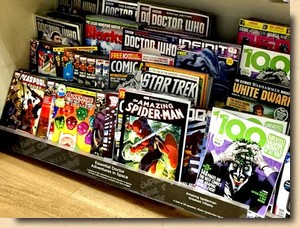
|
|
| |
| Established
in the mid-1970s, resellers could order comic books
through distributors with larger discounts to offset the
non-returnability and might also get their copies a week
ahead of the newstand sellers. The latter system, with
returnability and low discounts, ran in parallel to the
direct market for a number of years until the direct
market became the more important sales channel in the
mid-1980s. |
| |
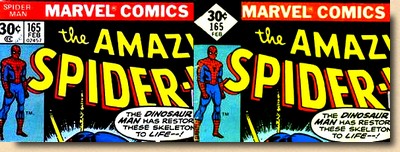 |
|
With both
business models in operation, it became necessary
for publishers to be able to distinguish a
newsstand edition (which was returnable and hence
refundable) from a direct market edition (which
was the retailer's problem if not sold).
Marvel's
initial solution, introduced in February 1977,
was a large white diamond on a black background
in the upper left-hand corner, replacing the
established price / number / month fields.
|
|
| |
| Several other means of
quick visual identification were established (and
sometimes dropped just as quickly, such as the barcode
struck through with a diagonal black line), but they only
concerned the covers as the contents were identical. But
the change introduced by DC for its October 1981 cover
date production also did away with pence price variants
at the same time. |
| |
| Whereas Batman #339
had also been produced as a standard 15p price
variant, the following newsstand issue featured
both the US price in large and the UK price in
smaller font within the same cover vignette. Together with
the barcode (which the direct market variant
lacked) this new multi-pricing became the prime
visual distinction for the copies sent out to the
traditional newsstand sales points. It also,
effectively, did away with the need to print yet
another cover variant for the UK market - and
thus spelled the end for the separate DC pence
price variants.
| |
|
|
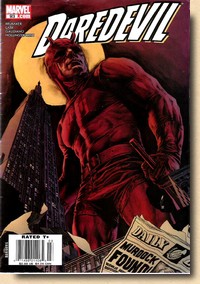
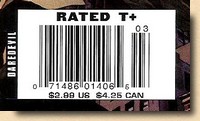 |
|
Marvel continued
their pence price variants production up
until December 1981. As of January 1982,
they took the opposite approach to their
main competitors by having their direct
market edition also feature
multi-country pricing one one single
cover. The effect for the
pence price variant was, of course, the
same - it ceased to exist as it
effectively became a part of the direct
market edition.
Printing multiple
currency cover prices on one cover lasted
well into the mid-1990s at Marvel before
it was ultimately reduced to just
featuring US and Canadian prices.
Daredevil #93 from 2007 illustrates a
newsstand edition, bought from a spinner
rack at Miami Airport, as also having
this feature.
So was this the end
of pence price variants? Strictly
speaking, yes. But there is a grey zone.
|
|
|
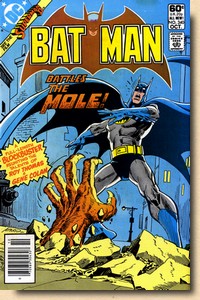 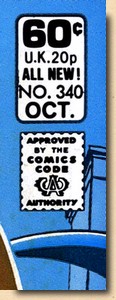
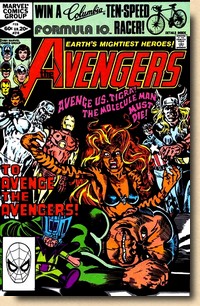 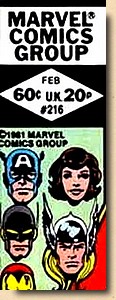
|
|
| |
Defining pence price
variants as such poses no problem at all - they are:
"Cover Price
Variants intended for foreign distribution with
limited regional distribution [i.e. for pence price
variants: UK only], published simultaneously with
standard or "regular" editions. The indicia
and all aspects of the book, except for the cover
price and sometimes the company logo, are identical
to a regular U.S. edition." (McClure, 2010)
|
| The vast majority of pence
price variants produced by US publishers in the
1960s, 1970s and very early 1980s had their UK
currency price printed directly on the cover,
i.e. as a result of the original printing and
binding process in the US. However, when the first
American comic books were officially imported and
distributed to newsagents in Great Britain in
October 1959 (the issues were Batman
#127 and Superman #132) this was not the
case.
As a consequence,
the UK distributors Thorpe & Porter needed to
indicate to the newsagent how much he was to
charge his customers for this product - which
only carried a printed price in US cents. The
simple solution was to apply an ink stamp to the
cover which spelled out the British currency
price.
As a result, all DC
titles imported to the UK were sold marked with a
9d (9 pence) stamp on the cover in late 1959.
This most likely manual pricing process only
lasted a few months, and when Thorpe & Porter
started to import Atlas/Marvel comic book titles
the UK currency price was printed onto the cover.
So should those
stamped comic books already be considered to be
true pence price variants or were they simply US
comic books defaced with a rather large stamp?
Opinions vary, but
anecdotal examples from 2017 may be helpful in
arriving at a consistent conclusion.
|
|
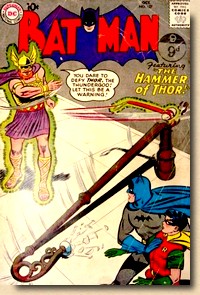
UK import Batman #127 (Oct 1959) with
9d. price stamp
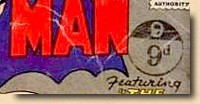
|
|
| |
| Forbidden Planet (which
goes back to humble beginnings in 1978 on London's
Denmark Street) is today, according to their own website,
"the world’s largest and best-known science
fiction, fantasy and cult entertainment retailer and the
largest UK stockist of the latest comics and graphic
novels". They also have a long standing
reputation for putting their own price stickers on comic
books. |
| |
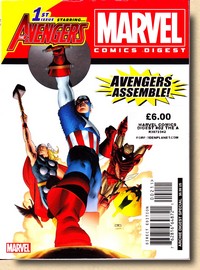
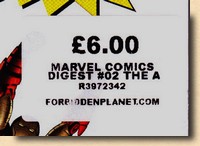
|
|
Marvel Comics Digest
#2, published in August 2017 by Archie Comics and
reprinting stories from the 1960s through to the
2000s in the well-established and highly
successful "Archie Digest" format is an
example of this practice.
Bought
at the FP London Megastore on Shaftesbury Avenue,
the price sticker does fill the information gap
for the potential buyer as to the UK price of
this comic book (which only has its US price
printed on its cover). The salesperson at the
cash till won't need it, though, as the barcode
will be scanned.
The
sticker (impossible to remove without damaging
the cover) also clearly states where the comic
book was purchased - although there seem to be a
few exceptions.
True
Believers: Kirby 100th – Nick Fury #1,
published in August 2017 along with a few other
titles by Marvel in order to celebrate Kirby's
100th birthday anniversary, is such an oddity.
|
|
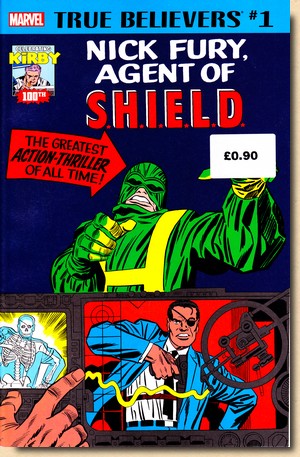
|
|
| |
| Reprinting material from Strange
Tales #135 and #141, this particular copy (also
bought at the London Megastore) carries an otherwise
blank 90 pence price sticker - which also proved to
actually not be the correct price at the cash till (it
was 85p). Taken out of context, there is no way of
knowing who applied the price sticker - so could either
or both of these examples be considered a pence price
variant in analogy to the 1959 stamped DC issues? |
| |
| The FORBIDDENPLANET.COM price
sticker has to be dismissed because apart from
having been applied by a specific retailer (i.e.
after the distribution process) is in fact often
also applied to publications produced in the UK
for the British market only. One such
example is the Marvel Pocketbook (vol. 2) from
2014 featuring Thor. Bought at the Croydon FP
store, this sticker is actually completely
unnecessary as the identical price (£6.99) is
printed on the back cover.
The
blank price sticker on True Believers: Kirby
100th – Nick Fury #1 tells a similar
story - it is ultimately only a copy marked by a
specific retailer and not an actual systematic
distribution variant. It really only appears
fuzzy when the known context is not taken into
account, as questions would then arise when and
where the sticker was applied.
So clearly these two
anecdotal 2017 examples are not pence price
variants but rather comic books marked as having
been sold by Forbidden Planet. But what kind of
light does this shine on the Thorpe & Porter
rubber stamped comic books from 1959?
|
|
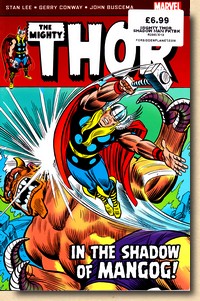
|
|
| |